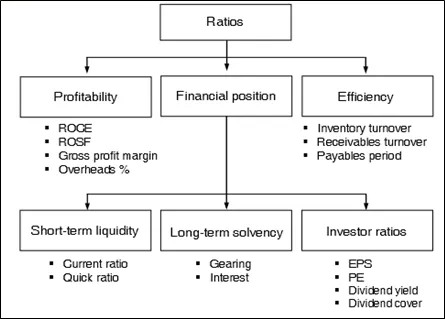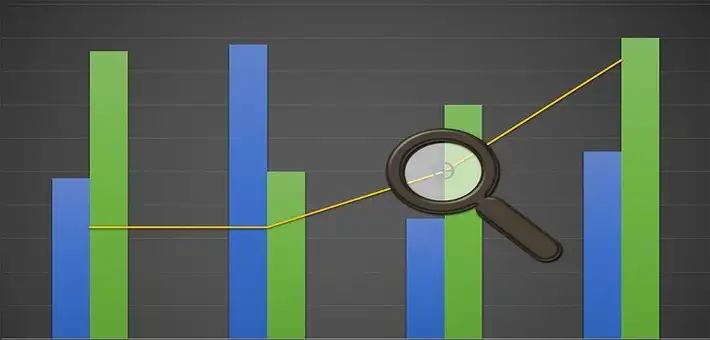Overview
Ratios are useful for assessing the performance of a company. When ratios are used to compare different companies, the comparability is affected if companies use different accounting policies to prepare their financial statements. These Ratios summary notes are prepared by mindmaplab team and covering, Ratios revised amendment, the key definitions, full standard with illustrative examples, the financial ratios analysis, accounting ratio, performance ratios, types of ratio analysis, the key and important financial ratios, ratio analysis in management accounting, the use of ratio analysis, including the most important financial ratios to analyze a company. This is actually a financial ratios cheat sheet. This is the Ratio and Trend analysis full text guide; we have also prepared Ratio and Trend analysis pdf version download.
IAS Standards
IAS 2 Inventories
IAS 7 Statements of cash flows
IAS 7 Statement of cash flows – Revisited
IAS 8 Accounting policies, changes in accounting estimates, and errors
IAS 10 Events after the reporting period
IAS 16 Property, plant and equipment
IAS 20 Accounting for government grants and disclosure of government assistance
IAS 21 The effects of changes in foreign exchange rates
IAS 24 Related party disclosures
IAS 27 Consolidated and separate financial statements
IAS 28 Investments in associates and joint ventures
IAS 32 Financial instruments: presentation
IAS 33 Earnings per share – Revisited
IAS 37 Provisions, contingent liabilities and contingent assets
IFRS Standards
IFRS 5 Non-current assets held for sale and discontinued operations
IFRS 7 Financial instruments: disclosures
IFRS 10 Consolidated financial statements
IFRS 12 Disclosure of interests in other entities
IFRS 13 Fair value measurement
IFRS 15 Revenues from contracts with customers
IAS 17 VS IFRS 16 Lease – Differences
Categories of financial ratios
Ratios can be divided into five categories:

*Remember that when a ratio is calculated, it is important to compare ‘like with like’.
Profitability ratios
This category of ratios measures the performance of the company in terms of the return (profit) earned on the capital employed in the business. These ratios are relevant for measuring the success of management in using the resources and allow customers and suppliers to assess whether the company has the ability to continue operating successfully in the future.
Return on (total) capital employed (ROCE)
The return on capital employed ratio measures profit before interest and tax with the total capital employed in the business. It is therefore a measure of the success of the company in making use of its invested capital.
Profit before interest and tax x 100
Share capital + reserves + debt capital
Return on shareholders’ funds (ROSF)
The return on shareholders’ funds (ROSF) or return on shareholders’ capital (ROSC) measures the return on the capital invested by shareholders.
In a company with no preference shares and no non-controlling interests, this ratio is calculated as follows:
Profit before tax x 100
Share capital + reserves
When a company has non-controlling interests or preference shares, you need to decide on the most suitable method of calculating the ratio.
Using ROCE or ROSF – It is not necessary to calculate both these ratios. The ratio that you calculate should be the ratio that is of the greatest interest to the particular user or user group.
Gross profit percentage
The gross profit margin is the ratio of gross profit to sales income.
This ratio should normally remain fairly constant from one year to the next. Even a fairly small change in the ratio might indicate that something of significance has happened.
Variations between years may be attributable to:
- a change in sales prices
- a change in sales mix
- a change in purchase/production costs
- an exceptional write-off of inventory
Gross profit x 100
Sales
Overhead percentage
Overhead percentage ratios measure the ratio of overhead costs to sales revenue. The main overhead costs are administrative expenses and sales and distribution costs.
The ratio of variable overhead costs to sales revenue should remain constant from one year to the next, unless something of significance happens
The ratio of fixed overhead costs to sales revenue should decrease as the company grows and increases its annual revenue.
Overheads x 100
Sales
Efficiency ratios
Cash flow is the lifeblood of an entity. Cash is needed to maintain operations by paying suppliers and employees, and to allow the company to grow.
The operating cycle (also called the cash cycle) refers to the continuous cycle of business activities, whereby an entity spends cash to acquire materials, labour and other resources, and eventually recovers its cash (with a profit) by selling goods or services to customers and collecting payment.
Poor working capital management and an inefficient cash cycle mean inadequate cash flows.
When an entity ties up capital in excessive working capital (inventory and trade receivables) its ROCE will be lower than it should be, and it may need to borrow money to meet its obligations.
Several working capital efficiency ratios are useful for assessing the efficiency of working capital management and management of the operating cycle/cash cycle.
Inventory turnover
Inventory turnover is a measure of how quickly an entity uses its inventory. It is also a measure of how slowly an entity uses its inventory, and how long items are held in inventory before they are eventually used or sold.
Inventory turnover may be measured as ‘x times a year’.
Cost of Sales
Average Inventory
A low turnover indicates inefficient use of resources. The slower inventory turnover, the greater the risk of obsolescence.
Inventory turnover may also be measured as an average number of days, rather than as ‘x times a year’.
Average Inventory x 365
Cost of Sales
This calculates the number of days a company takes to sell its average holding of inventory.
Separate turnover ratios could be calculated for:
- raw materials
- work in progress (the production cycle), and
- finished goods
Receivables turnover
It is sometimes called ‘debtor days’ or ‘days sales outstanding’. The receivables turnover ratio is usually measured in days. It is the average time that it takes an entity to collect amounts due from customers.
Average Trade Receivables x 365
Credit Sales
The ratio should ideally use credit sales, but the financial statements do not provide an analysis of sales into cash sales and credit sales. Therefore, total sales must normally be used, and this may produce an unrealistic ratio.
A change in the ratio from one year to the next may be due to:
- A change in settlement terms for credit customers, to encourage new business
- the introduction of debt factoring, which will reduce the average receivables collection period
- exceptional factors, such as one large new customer being offered extended credit.
Payables payment period
It is the average payment period to suppliers. It is normally measured in days.
Average Trade Payables x 365
Credit Purchases
The ratio should ideally use purchases on credit. However, this figure is not available from the financial statements, and the figure for the annual cost of sales should be used instead.
Short-term liquidity ratios
Short-term liquidity ratios are used to assess the ability of an entity to have sufficient cash, normally from its normal business cycle/cash cycle, to settle payments when they become due.
The ratios can be used together with information in the statement of cash flows to analyse the liquidity (and cash flows) of the entity.
Current ratio
Liquidity comes from current assets, including cash. The need for liquidity comes from the need to settle current liabilities.
The current ratio is simply a ratio that compares short-term sources of cash (current assets) with short-term needs for cash (current liabilities).
Current assets
Current liabilities
As a very rough guide, an ‘ideal’ current ratio may be 1.5:1 or 2:1. A ratio of less than 1:1 could indicate liquidity problems, because the entity might be unable to obtain cash from normal business activities to settle its current liabilities.
Quick ratio (acid test ratio)
Inventory turnover could be very slow. In such cases, inventory is not a liquid asset and will not generate cash within a fairly short period of time in order to pay off the current obligations due in the next month or so.
The quick ratio or acid test ratio is similar to the current ratio, but it excludes inventory from current assets.
Current assets (less) Inventory
Current liabilities
By eliminating inventory, the quick ratio measures a worst-case-scenario. It can be used to ask the question: Does the entity appear to have sufficient cash and near cash assets (including receivables) to provide the money to settle all current liabilities on time?
‘Ideally’ the quick ratio should be about 0.8:1 to 1.0:1.
Long-term solvency ratios
A company finances its net assets with a combination of equity and reserves and long-term debt. An entity is ‘high geared’ when a large proportion of its long-term capital is in the form of debt. High financial gearing is seen as a high-risk strategy.
‘Gearing’ examines the financing structure of a business and indicates to shareholders the level of financial risk to which the company is exposed because of its long-term capital structure.
These ratios, and changes in the ratios over time, can help them to assess the credit risk in their investment.
Gearing ratio
The gearing ratio (or leverage ratio) is usually calculated as follows:
Debt or Debt x 100
Equity Equity + Debt
Debt = Loans + Preference shares
Equity = Equity share capital + reserves + non-controlling interest
Notes on financial gearing
- A highly geared company, with a substantial proportion of its capital in the form of debt, is seen by investors as ‘more risky’.
- High gearing is acceptable if it is accompanied by stable annual profits (PBIT) or increasing profits.
- A highly-geared company may find it more difficult to raise additional debt capital.
Interest cover
The interest cover ratio measures the ability of a company to meet its obligations to pay interest on debt (out of its profits).
The ratio therefore compares profit before interest and tax with the annual interest charges.
Profit before interest
Interest
A high interest cover suggests a sensible financing structure.
An interest cover of 2 times or less generally indicates that the company might have difficulty paying its interest if there is a fall in its profits.
Investor ratios
Four widely-used ratios are:
- earnings per share
- the P/E ratio
- dividend yield
- dividend cover
Dividend yield
The dividend yield measures the annual cash return (dividends) that equity shareholders are receiving on their investment.
Net dividend per share + tax credit x 100
Current market share price
Where there is no system of tax credits on dividend payments, the figure for dividends is simply the annual cash dividends paid to shareholders.
Dividend cover
The dividend cover ratio measures the earnings of a company relative to the size of its dividend payments.
EPS
Net dividend per share
Limitations of financial ratios
Most of the data for calculating financial ratios comes from the financial statements.
- The reliability of ratios is therefore affected by the reliability of the financial statements themselves.
- When ratios are used to compare different companies, the comparability is affected if companies use different accounting policies to prepare their financial statements.
